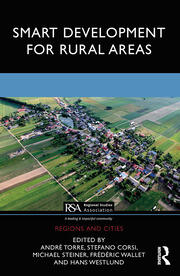Interview with André Torre by Joan Fitzgerald

Interview by Joan Fitzgerald, Editor-in-Chief, Regions and Cities Book Series Northeastern University, Boston, Massachusetts, USA.
André Torre is a Professor at the University of Paris-Saclay. He is the President of ERSA (European Regional Science Association) and a research professor at France’s National Institute for Agricultural Research (INRAE). André is the lead editor of Smart Development for Rural Areas* (2020), published in the Routledge-Rregional Studies Association Regions and Cities book series.

Joan Fitzgerald (JF): How did the idea of this edited volume come about?
This volume has a double origin. The first and most obvious is the link with the European H2020 project TASTE, which I managed with pleasure for a few years. In this project, we asked ourselves about the possibility of smart development in rural areas, based on the observation of a lag in the development of these territories, especially at the European level, as well as the persistent inequalities that characterize them. We decided to start to study this question with some of the best researchers in Europe in this field, and propose solutions.
The second is more personal and comes from a suggestion by Michael Steiner, one of the book’s co-authors. He had the opportunity to publish with Routledge and said, “André, we should do a book with them, it will be very simple and they are very nice.” And I have to say it’s true!
JF: Why do smart development policies not work in rural areas? How can they be adapted?
André Torre (AT): Smart development policies are based on a good idea: they aim to make innovations (especially technological networks of innovations included in a regional value chain) available to all audiences and to enable the development of all regions, whatever their characteristics. They have been implemented this way by the EU.
Unfortunately, the implementation of these policies in Europe is proving very difficult in peripheral areas, especially in rural areas. The latter are characterized by their small population, their dispersed character, the fact that not all economic activities or stages of the value chains are present locally, the fact that innovation training centers are not very present locally, and finally, their economies are rarely based on a high level of technology, with rare exceptions. And precisely, these are the conditions required for good smart development policies!
In fact, our studies show that it is necessary to adapt smart development policies to the peculiarities of rural areas. In our book, we give directions to achieve this goal:
- Make use of local amenities, be there natural amenities (land and water resources, mountains and lakes), or built amenities (summer and winter-based recreational activities, local foods…), and social and cultural amenities (special sites and buildings, local culture and tradition including food, crafts, festivals and lifestyles)
- Improving the multidimensionality of infrastructures
- Support variety and diversity in business operations, to promote the creation of local networks and local brands, including in agricultural or tourist activities
- “Borrow size” means borrowing several elements from neighboring regions, such as R&D centers, innovation training centers, etc.
- And managing land uses, in order to avoid too many incompatible uses which lead to conflicts, and impossibility to launch joint projects at the local scale.
JF: Your book focuses on the EU—are there effective practices that other regions can replicate?
AT: It is true that we have focused on the EU in our book, for two main reasons: it is our playground, the area where we know the territories, to live and work there; and also because it is the place where smart development and smart specialization policies are applied in a priority manner.
But the validity of our work goes well beyond the EU. Indeed, the characteristics of the rural areas we have identified are found in all countries of the world, whether developed or emerging.
And rural policies are all a bit similar, as I’ve had the opportunity to show in other publications. Either they consist of a replication of general policies, or they focus solely on agricultural dimensions.
From this point of view, the EU’s smart development policies are rather ahead of others. That’s to say!
So, yes, our book and the conclusions we present apply to all countries and all rural areas, especially in Europe.
JF: You have case studies on Sweden, Italy, France, and Austria—are there leaders in rural innovation?
AT: The choice of these case studies reflects very different situations of rural areas in Europe, but always innovative, which is why we chose them.
In Sweden, we have found regions that are often very peripheral, with a strong spirit of independence and a fierce desire for development, from local own resources. In Italy, we focused on the north of the peninsula, where development questions appear more periurban and perirural, with issues turning around agriculture and its development and the relationship to the feeding of the cities. In France, a large country, the examples were varied and ranged from areas near cities to development experiences in remote and innovative territories in terms of products of origin or third places. Finally, in Austria, we have discovered very active rural territories, focused on both business and the development of cultural activities;
So, yes, the diversity of our case studies is particularly impressive, and reflects the real capacity for innovation and dynamism of rural areas, often outside the standard path of smart development doxa.
JF: Have you been able to verify the validity of these theses in other regions or countries?
AT: I have had the opportunity to study rural and periurban areas in various places through my work in countries such as China, Brazil, Chile and Pakistan for example. In all cases we find the same type of problems. These are areas that are highly appreciated for their calm, their very natural or agricultural character, and also often for their landscapes and their culture or local food. But they are also territories that are often difficult to access, in which there is a lack of means and poverty compared to cities and a lower level of education. Moreover, these areas suffer from transport problems, they are often isolated, and even the internal links are very weak. And also they are often behind in terms of digitization, there is a strong digital divide, and some of the inhabitants are not users of digital technologies, while the internet or 3G networks, for example are not always easily accessible.
The solution then lies, as we have shown for Europe in the book Smart Development for Rural Areas, in using the assets of these territories, such as their agricultural production, their landscapes or their cultural amenities, to base their development and integration in growing economies, taking into account the well-being of populations.
*Smart Development for Rural Areas,
Further reading in Regions e-zine:
Dissemination support for authors publishing in the RSA’s Regions and Cities Book Series, By Daniela Carl is Deputy Chief Executive Officer at the Regional Studies Association (Issue 15).
Book review: Smart Development for Rural Areas, By André Torre, Stefano Corsi, Michael Steiner, Frédéric Wallet, Hans Westlund (Issue 12).